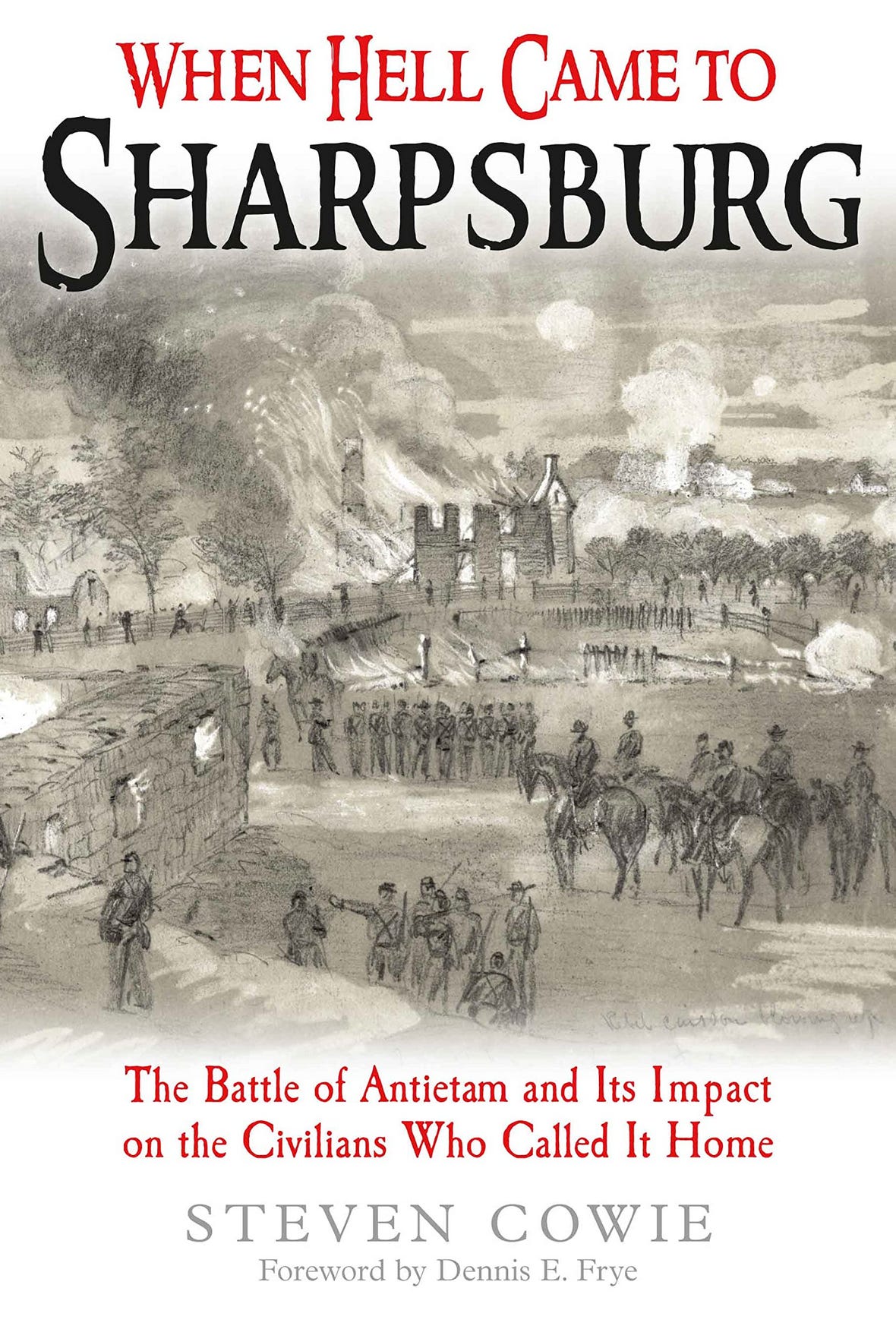My introduction to the Civil War took place on the Antietam battlefield back in 1994. In fact, my first published piece, which appeared at about this time in The Washington Times, focused on the civilian experience during the battle. I’ve returned many times since. It’s an incredibly powerful landscape on which the experiences of soldiers and civilians are intertwined on multiple levels.
It is with this in mind that I read through Steven Cowie massive new book, When Hell Came to Sharpsburg: The Battle of Antietam and Its Impact on the Civilians Who Called It Home. This is Cowie’s first book and it is the result of years of research. Let me start by saying that this is not the kind of Civil War book that I tend to read. Let me explain.
Most of the books I read are written by historians who emphasize interpretation and who make a conscious attempt to situate their study in a larger historiography. I don’t want to get bogged down in the tired distinction between analytical and narrative history or academic v. popular historians, but let’s just say that Steven Cowie’s book is extremely heavy on narrative.
This is an exhaustive account of the civilian experience before, during, and after the bloody battle that took place along the Antietam on September 17, 1862. The research is impressive, especially the author’s use of the war claims collection housed at the National Archives.
The detail that Cowie packs into this book is impressive and at times overwhelming. The destruction of the interior and exterior of buildings by artillery, along with the ransacking committed by men on both sides is thoroughly described. The impact of the battle on the landscape itself is explored in excruciating detail, down to the destruction of trees, the amount of corn and wheat that was destroyed and utilized in some fashion by the armies, and the impact of the waste of thousands of men and horses on the water and food supply.
This is one of the few publishers that utilizes footnotes instead of endnotes, many of which are quite extensive and will be greatly appreciated by readers looking for even more detail and description.
Cowie paints a vivid picture of the battlefield and the scale of death that confronted local citizens, along with the toll that the Army of the Potomac took during its extended stay in and around Sharpsburg.
One of my favorite chapters covers the supply chain problems faced by the Army of the Potomac after the battle. Cowie rightfully steers clear of addressing the debate about Gen. George B. McClellan’s inaction, but his emphasis on the condition of the army’s horses should figure into any assessment of his decision not to pursue the Army of Northern Virginia.
Some readers may wonder whether at some point the amount of descriptive material leads to diminishing returns. How many examples of dismembered bodies or shattered buildings is enough?
I offer this observation only because there are a number of missed opportunities to more thoroughly interpret the evidence included in this book. Though Cowie does include references to the experiences of African Americans during and after the battle, he could have gone much further in placing their voices in context. The same can be said for his handling of the evidence of political divisions among civilians in and around Sharpsburg.
Finally, the burgeoning field of environmental history could have helped Cowie think even more deeply about how battle and armies reshaped natural landscapes and what this meant to the civilian population.
That said, though at times the amount of detail was exhausting, I am convinced that there is a certain perspective on the civilian experience that can only be achieved by wading through all of Cowie’s narrative.
One of the best features of this book are the maps. These are some of the most detailed maps of the homesteads and farms around Sharpsburg that you will find. Cowie also includes a wonderful map of Sharpsburg that includes individual numbered lots.
The maps allow you to pinpoint the location of individual accounts throughout the book as well as follow the movements of civilians before, during, and after the battle. The result is that you see the battle and its aftermath from many different points on the landscape and through the eyes of the individuals and families who lived through it. Ultimately, you also feel as if you’ve experienced the battle alongside the residents of Sharpsburg.
I have no doubt many readers are going to appreciate this particular aspect of the book.
Congratulations to Steven Cowie on the publication of his first book. His book offers an important reminder that a battle never ends after the final shot is fired.





Thank you for taking the time to read and critique the book, Kevin. I sincerely appreciate it.
Steve
My husband and I have lived in Sharpsburg now for 5 years. The house we bought was built in the late 18th century. There are published stories about 2-3 Confederate soldiers being killed in our house when an artillery shell came through it, one dead soldier being found with a bunch of pilfered onions in his hand. A newspaper story from around Antietam’s centennial mentioned our house was used as a hospital, the last wounded soldier vacated in January 1863. What is claimed to be bloodstains remains on the original pine floor in our parlor.
I’m eager to read Cowie’s book. We heard him speak recently about the book. He’s an engaging speaker, and the audience, I assume mostly Sharpsburg/Washington County residents, was greatly enthused by his presentation. I appreciate your critique of the book. Perhaps it will appeal to a more narrow readership than Cowie intended. I’m hoping to get my hands on this book soon.